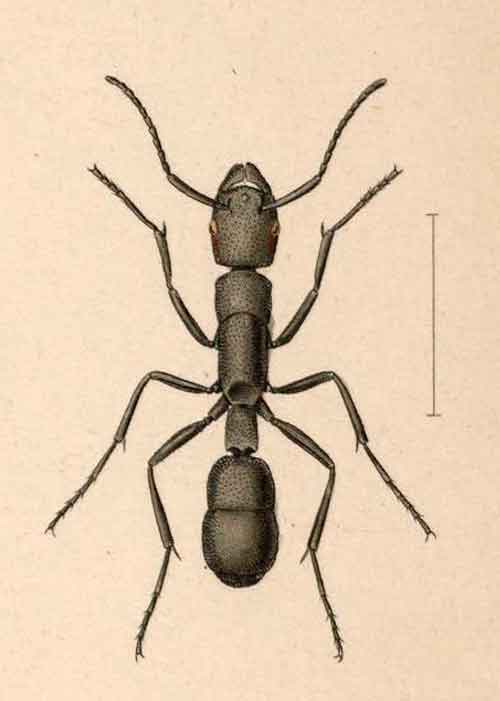Superregnum: Eukaryota
Cladus: Unikonta
Cladus: Opisthokonta
Cladus: Holozoa
Regnum: Animalia
Subregnum: Eumetazoa
Cladus: Bilateria
Cladus: Nephrozoa
Cladus: Protostomia
Cladus: Ecdysozoa
Cladus: Panarthropoda
Phylum: Arthropoda
Cladus: Pancrustacea
Cladus: Allotriocarida
Subphylum: Hexapoda
Classis: Insecta
Cladus: Dicondylia
Subclassis: Pterygota
Infraclassis: Neoptera
Cladus: Eumetabola
Cladus: Holometabola
Superordo: Hymenopterida
Ordo: Hymenoptera
Subordo: Apocrita
Superfamilia: Formicoidea
Familia: Formicidae
Subfamilia: Ponerinae
Tribus: Platythyreini
Genus: Platythyrea
Species: P. angusta – P. arnoldi – P. arthuri – P. bicuspis – P. bidentata – P. brunnipes – P. clypeata – P. conradti – P. cooperi – P. cribrinodis – P. crucheti – †P. dentata – P. dentinodis – †P. dlusskyi – P. exigua – P. frontalis – P. gracillima – P. homasawini – P. inermis – P. janyai – P. lamellosa – P. lenca – P. matopoensis – P. micans – P. mocquerysi – P. modesta – P. nicobarensis – P. occidentalis – P. parallela – P. pilosula – †P. primaeva – P. prizo – †P. procera – †P. pumilio – P. punctata – P. quadridenta – P. sagei – †P. scalpra – P. schultzei – P. sinuata – P. strenua – P. tenuis – P. tricuspidata – P. turneri – P. viehmeyeri – P. zodion
Name
Platythyrea Roger, 1863: 172
Type-species: Platythyrea punctata, by subsequent designation of Bingham, 1903: 73.

Platythyrea cribrinodis
References
Primary references
Roger, J. 1863. Die neu aufgeführten Gattungen und Arten meines Formiciden-Verzeichnisses nebst Ergänzung einiger früher gegebenen Beschreibungen. Berliner entomologische Zeitschrift 7: 131-214. BHL Reference page. [original description: p. 172]
Additional references
Aria, C.; Perrichot, V.; Nel, A. 2011: Fossil Ponerinae (Hymenoptera: Formicidae) in Early Eocene amber of France. Zootaxa, 2870: 53–62. Preview
Jaitrong, W., Xu, Z-H. & Khachonpisitsak, S. 2022. A new species of the ant Platythyrea clypeata species group (Hymenoptera, Formicidae, Ponerinae) from continental Asia. Zookeys 1115ː 151–168. DOI: 10.3897/zookeys.1115.86477 Open access Reference page.
Phengsi, N., Jaitrong, W., Ruangsittichai, J. & Khachonpisitsak, S. 2018. A sibling species of Platythyrea clypeata Forel, 1911 in southeast Asia (Hymenoptera, Formicidae, Ponerinae). ZooKeys 729: 87–102. DOI: 10.3897/zookeys.729.21378. Reference page.
Platythyrea is a genus of predaceous ants in the subfamily Ponerinae and the sole member of the tribe Platythyreini.[2]
Distribution
The genus has a worldwide distribution, and is found in the tropics and subtropics of the world.[3]
Description
Workers are small to very large in size (4–20 mm). Gamergates (reproductive female workers) are known from all studied species except one, P. conradti, which have ergatoid queens (wingless reproductive ants, intermediate in form between workers and winged queens). Some species with gamergates also have alate queens, which are similar to the workers but winged.[3]
The effects of central fusion and terminal fusion on heterozygosity
Parthenogenesis
Parthenogenesis is a natural form of reproduction in which growth and development of embryos occur without fertilisation. Thelytoky is a particular form of parthenogenesis in which the development of a female individual occurs from an unfertilized egg. Automixis is a form of thelytoky, but there are different kinds of automixis. The kind of automixis relevant here is one in which two haploid products from the same meiosis combine to form a diploid zygote (see diagram).
Colonies of Platythyrea punctata from Florida and the Caribbean Islands produce offspring almost exclusively by automictic thelytoky.[4] Automixis appears to involve central fusion of two of the haploid products of meiosis (see diagram). This form of automixis tends to maintain heterozygosity in transmission of the genome from mother to offspring, and to minimize inbreeding depression. Furthermore, crossover recombination occurs at a greatly reduced rate during meiosis,[4] which likely restrains the transition from heterozygosity to homozygosity.
Species
Platythyrea angusta Forel, 1901
Platythyrea arnoldi Forel, 1913
Platythyrea arthuri Forel, 1910
Platythyrea bicuspis Emery, 1899
Platythyrea bidentata Brown, 1975
Platythyrea brevidentata Wheeler, 1922
Platythyrea brunnipes (Clark, 1938)
Platythyrea clypeata Forel, 1911
Platythyrea conradti Emery, 1899
Platythyrea cooperi Arnold, 1915
Platythyrea cribrinodis (Gerstäcker, 1859)
Platythyrea crucheti Santschi, 1911
†Platythyrea dentata Lattke, 2003
Platythyrea dentinodis (Clark, 1930)
†Platythyrea dlusskyi Aria, Perrichot & Nel, 2011
Platythyrea exigua Kempf, 1964
Platythyrea frontalis Emery, 1899
Platythyrea gracillima Wheeler, 1922
Platythyrea inermis Forel, 1910
Platythyrea lamellosa (Roger, 1860)
Platythyrea lenca De Andrade, 2004
Platythyrea matopoensis Arnold, 1915
Platythyrea micans (Clark, 1930)
Platythyrea mocquerysi Emery, 1899
Platythyrea modesta Emery, 1899
Platythyrea nicobarensis Forel, 1905
Platythyrea occidentalis André, 1890
Platythyrea parallela (Smith, 1859)
Platythyrea pilosula (Smith, 1858)
†Platythyrea primaeva Wheeler, 1915
Platythyrea prizo Kugler, 1977
†Platythyrea procera Lattke, 2003
†Platythyrea pumilio De Andrade, 2004
Platythyrea punctata (Smith, 1858)
Platythyrea quadridenta Donisthorpe, 1941
Platythyrea sagei Forel, 1900
†Platythyrea scalpra Lattke, 2003
Platythyrea schultzei Forel, 1910
Platythyrea sinuata (Roger, 1860)
Platythyrea strenua Wheeler & Mann, 1914
Platythyrea tenuis Emery, 1899
Platythyrea tricuspidata Emery, 1900
Platythyrea turneri Forel, 1895
Platythyrea viehmeyeri Santschi, 1914
Platythyrea zodion Brown, 1975
References
Bolton, B. (2015). "Platythyrea". AntCat. Retrieved 10 January 2015.
"Genus: Platythyrea". AntWeb.
Schmidt, C. A.; Shattuck, S. O. (2014). "The higher classification of the ant subfamily Ponerinae (Hymenoptera: Formicidae), with a review of ponerine ecology and behavior". Zootaxa. 3817 (1): 1–242. doi:10.11646/zootaxa.3817.1.1. PMID 24943802.
Kellner, Katrin; Heinze, Jürgen (2010). "Mechanism of facultative parthenogenesis in the ant Platythyrea punctata". Evolutionary Ecology. 25 (1): 77–89. doi:10.1007/s10682-010-9382-5. S2CID 24645055.
Retrieved from "http://en.wikipedia.org/"
All text is available under the terms of the GNU Free Documentation License

